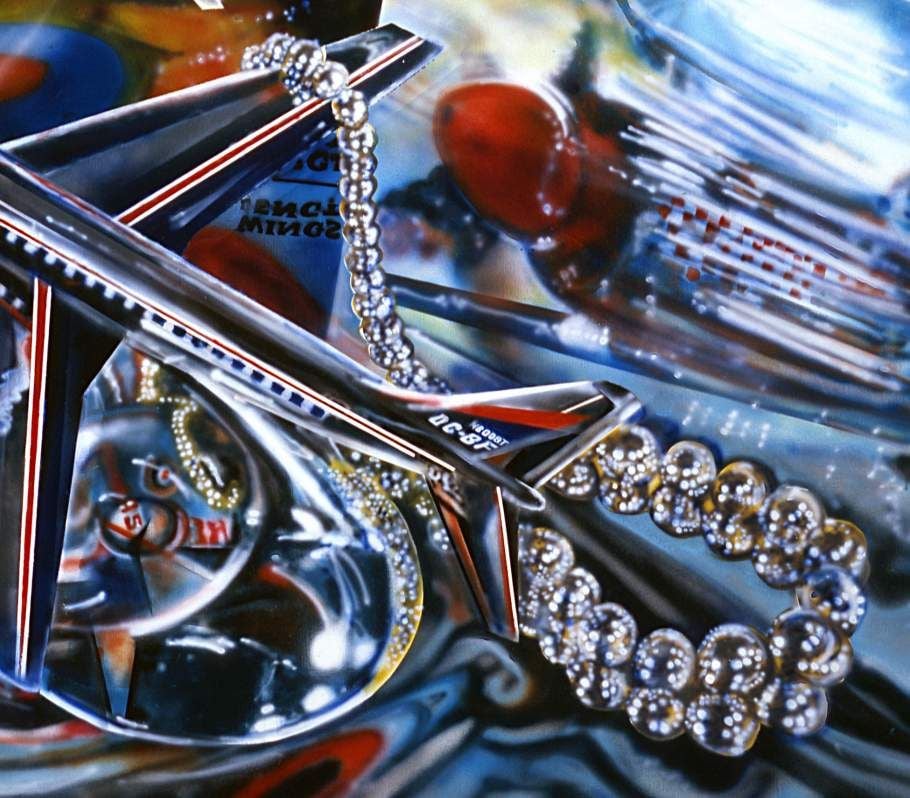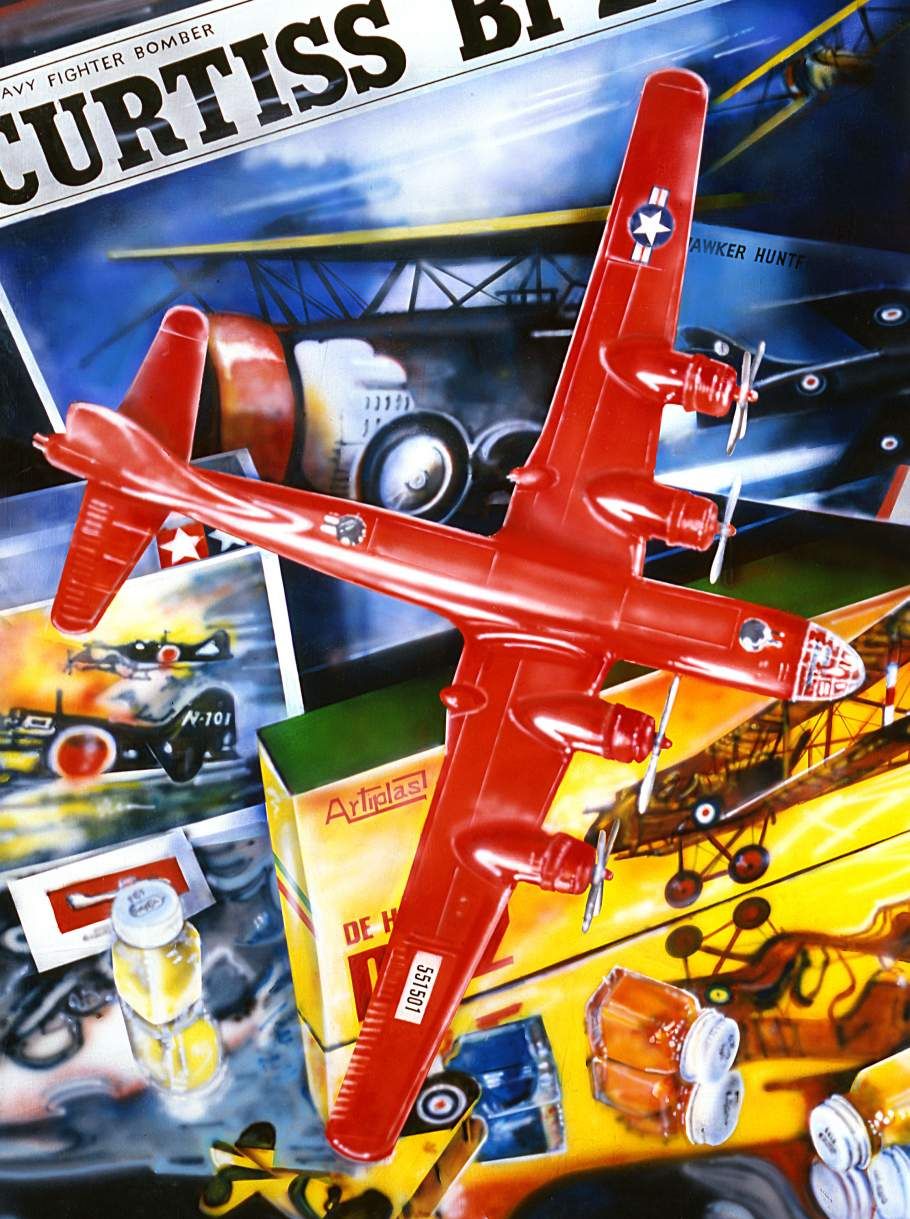Beneath the Surface: Audrey Flack’s Photorealism
Viewing the painting Spitfire, 1973, by photorealist painter Audrey Flack is like looking at a plane spotting puzzle.
:focal(720x531:721x532)/https://tf-cmsv2-smithsonianmag-media.s3.amazonaws.com/blogging/featured/1AudreyFlackSpitfire2002-32029.jpg)
Viewing the painting Spitfire, 1973, by photorealist painter Audrey Flack is like looking at a plane spotting puzzle. In eye popping primary colors, a playful arrangement of airplanes are depicted as boxed sets, built models, and playing cards to represent an array of aircraft. Graphics on unopened boxes display the names of some aircraft, such as the Supermarine Spitfire Mk.1a, Curtiss BF 2C-1, and the North American Mustang P-51, while images on boxes and cards depict others. Three commercial aircraft and a regional jet converge with their noses pointed towards a B-29 Superfortress bomber as if ready to collide. Reflections from the cellophane covered boxes and shiny tabletop, bounce light and patterns, creating a sense of depth and movement. This composition, with its precarious placement and jutted angles, borderlines on dizzying. But when one considers the perspectives of flight, the arrangement is natural and translates into an aerial view from multiple altitudes. Aside from the enhanced color saturation, most of the aircraft are true to their color scheme, except for the B-29, which jumps out with its unnatural color of red. Normally, the surface of a B-29 reveals the silver color of its metal alloy skin. At the lower right-hand corner of the painting lays a seemingly out of place strand of pearls coiled on the reflective tabletop and draped around the wing of a plane. This last detail of the necklace is a proclaimed symbolic statement by the artist (more on that later). Perhaps the choice of several WWII airplanes and a red B-29 are as well.
Flack’s Photorealism
Spitfire, 1973, is part of the Stuart M. Speiser Photorealism Collection, which comprises works by 22 prominent Photorealists including Richard Estes, Tom Blackwell, Ralph Goings, Richard McLean, Robert Bechtle, and Mel Ramos. Under the auspices of New York gallery owner Louis Meisel, the artists were commissioned for the assignment with the caveat to include an aircraft in the painting.
Photorealism in the 1970s was a distinctive phenomenon in which artists used photographs as the basis for a photo-like painting. For instance, instead of rendering a still life set-up, Flack composed the arrangement of the aircraft using string, gum, and other hidden props for a studio photograph which then became the source photo for the painting. Photorealists then transferred their photographic image to their canvas using either a slide projection or a grid pattern. Such paintings not only looked realistic or hyper realistic, but took on the cool unemotional vision of the camera lens. This type of painting is a radical departure from the emotional qualities of abstract expressionism, a movement which preceded Photorealism—think Jackson Pollock’s paint splatters, Mark Rothko’s color fields, or the abstractions of Norman Lewis and Elaine DeKooning.
Interestingly, Audrey Flack was initially an abstract expressionist and studied art at Yale University under Josef Albers, the renowned German abstract artist. Flack, however, takes liberties in her Photorealist art and admittedly imbues elements of emotion and symbolism into her work. This can be seen in the strand of pearls in Spitfire, which Flack has said represents “women’s interest in flight and that women can fly too.”1

Spitfire was made in the early 1970s during the second wave of feminism. Flack was one of the first female Photorealists of the original group of artists and the only woman artist invited to participate in the Stuart Speiser commission project. Initially, she refused since her subject matter was in part feminist and her male contemporaries were painting trucks, cars, motorcycles, and pin-up girls. Fortunately, Flack reconsidered the offer and contributed to the project with her personal associations of flight and her childhood interest in airplane model building during World War II.
Reflections of WWII
Like many kids during the World War II era, the young Flack quenched her passion for flight through model making, which allowed her to imagine experiences in the specialty planes. Unlike the mostly plastic models in Spitfire, which were gathered from flea markets and model shops in the 1970s for the photoshoot, Flack’s childhood models were made of balsa wood and tissue paper. Several of the types of aircraft in Spitfire were flown during WWII, like the namesake of the painting, the British fighter plane Supermarine Spitfire Mk. 1a; the North American P-51 Mustang; and the Japanese Mitsubishi J2M Raiden.
Flack’s oeuvre includes other references to the war, such as the paintings Hitler, 1963-1964, and World War II (Vanitas), 1976–1977. Her early painting of Adolph Hitler was copied from a news photograph where the Nazi leader appears to be laughing. As art historian Lawrence Alloway stated, “Flack’s problem was to coax a news photo of the 1940s into a psychological history picture: how do you paint the good humor of an evil man?”2 In World War II (Vanitas), Flack incorporated a black and white photograph by Life Magazine photographer Margaret Bourke-White of The Living Dead at Buchenwald, 1945 which shows the hollowed faces of concentration camp survivors staring into the camera lens from behind barbed wire. World War II (Vanitas) depicts an allegory of war and includes a blue butterfly to signify the release of the soul, a Hasidic quote about the trust in God from the Roman Vishniac book Polish Jews, and a red memorial candle to burn eternally in the painting in remembrance of the Holocaust victims and to serve as a bridge of time between 1945 and the present. During the photoshoot for that piece, drips of candle wax serendipitously fell onto the Hasidic quote which, Flack later noted, became symbolic for the bloodshed and the horrors of the Holocaust.3
As a Jewish American artist, the atrocities of the Holocaust remained close to Flack’s heart, and her WWII related paintings have great depth beyond what is seen at first glance. On the surface, Spitfire is a painting about color and composition and fulfills the requirements of a commission with the caveat to include airplanes. But it is easy to ponder if a deeper message was placed in the painting by the artist. Could the red painted B-29 Superfortress bomber be a symbolic gesture, either intentionally or subliminally, to signify the bloodshed inflicted on the innocents of war? After all, the B-29 Superfortress Enola Gay dropped the atomic bomb on Hiroshima, Japan, on August 6, 1945, and three days later the B-29 Bockscar dropped another on Nagasaki, Japan, which destroyed both cities and led to Japan’s surrender. By considering Spitfire through the lens of Audrey Flack’s approach to Photorealism and her associations to aviation in the 1940s, perhaps the painting also embeds some of the stories, beliefs, and emotions of the war.

To see more of Audrey Flack’s art visit audreyflack.com. Also, check out the newly released documentary film about the life and work of the artist Queen of Hearts: Audrey Flack.
Carolyn Russo is a museum specialist in the Aeronautics Division and is the curator of the art collection.
1 Audrey Flack, Interview by Carolyn Russo, Tape Recording. Artist’s Residence, New York, July 24, 2019.
2 Audrey Flack, Audrey Flack on Painting (New York: Harry N. Abrams, Inc., 1985), 20.
3 Ibid., 78-81

